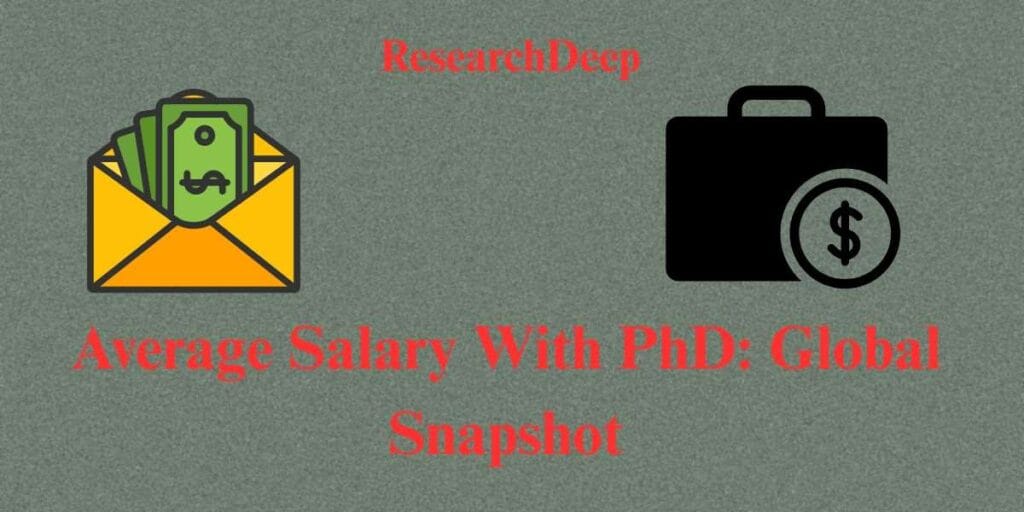Last updated on September 15th, 2025 at 12:23 pm
Introduction
There is no definitive average salary with PhD, because earnings vary widely by country, field of study, industry, and years of experience.
However, global datasets and occupational surveys provide helpful benchmarks to assess the average PhD salaries, while accounting for the main variables.
Below is a global snapshot summarizing typical early-career and experienced salary ranges by location and discipline, plus practical guidance for prospective PhD students (PayScale, 2023; U.S. Bureau of Labor Statistics, 2024)
This article reviews PhD salary ranges across countries and the most in-demand PhD degrees, offering an evidence-based overview for prospective doctoral students and researchers. These may include some of the subjectively-rated hardest PhD degrees and doctorates to earn.
Estimated PhD Salaries by Country
The numbers in the table are indicative early-career and mid-career ranges for PhD holders and reflect typical industry and research roles. Use them as benchmarks — actual pay depends on role (academic vs. industry), employer, and local cost of living.
| Country/Region | Average Range (Annual) | Entry-level industry roles; public sector salaries are dependent on the TV-L scales (Academics.com, 2024). |
|---|---|---|
| United States | 80,000 – $160,000 (early career); median ~$110,000 | Highest-paying fields, such as computer science, exceed $140,000 within four years (U.S. Bureau of Labor Statistics, 2024; PayScale, 2024). |
| Canada | CAD $80,000 – $120,000 | Provincial job data and salary aggregators show typical PhD roles in the CAD 80–120k band (ZipRecruiter / PayScale snapshots). |
| Germany | €60,000 – €70,000 | Entry-level industry roles; public sector salaries depend on TV-L scales (Academics.com, 2024). |
| United Kingdom | £27,000 – £51,000+ | The Graduate Outcomes survey (2022) found that 20% earned above £51,000 within 15 months (Universities UK, 2022). |
| Australia | AUD $70,000 – $140,000 | Industry roles and PayScale data show wide ranges; PhD student stipends are lower (Universities Australia report; PayScale AU). |
| India | ₹18,00,000 – ₹40,00,000 | Fresh PhDs often start at ₹8,00,000 – ₹12,00,000 annually; senior roles exceed ₹30,00,000 (CollegeVidya, 2024). |
Highest-Paying PhD Fields
Specific fields consistently yield higher median pay, especially when PhD holders move into industry or leadership roles. The following list aggregates government occupational data and salary aggregator medians.
- Computer and Information Sciences: Median annual salary is approximately $140,910 (U.S. Bureau of Labor Statistics, 2024).
- Immunology & Biotech: Clinical/industry roles in immunology and biotech report high medians (industry aggregator snapshots). The average salary is approximately $182,342 (Indeed, 2023).
- Pharmacology& Pharmaceutical R&D: Industry research scientists and senior scientists command six-figure salaries in the U.S The average annual salary is approximately $120,351 (PayScale, 2023).
- Engineering (Electrical, Aerospace, Petroleum): Engineered specialties in industry R&D and design yield strong pay (PayScale). Consistently strong salary growth, often exceeding $120,000.
- Economics& Quantitative Finance: Economists and quant researchers often move into high-paying government, consulting, and finance roles.Median salary is approximately $115,440 (U.S. Bureau of Labor Statistics, 2024).
- Data Science & Applied Statistics: PhDs with a specialization in data science are in high demand across the tech and finance sectors, often with top-tier compensation.
- Energy & Mining R&D: In some countries (e.g., Australia), resource-sector R&D and senior technical roles have strong pay packages.
Recommended Reads:
Factors Affecting PhD Salary
Many interacting factors drive salary variability. Below are practical items to evaluate when estimating likely earnings:
- Sector (Industry vs. Academia): Industry R&D and private-sector roles usually pay more than academic postdocs and early tenure-track positions (NSF; PayScale).
- Field / Specialization: STEM (computer science, engineering, Biotech) tends to pay more than many social sciences and humanities. Highly specialized applied skills (e.g., ML, quant finance) increase market value.
- Experience & Seniority: Salaries generally rise substantially after 5–10 years, when PhDs transition to senior research/managerial roles, or industry leadership.
- Geography & Cost of Living: Metro hubs (such as San Francisco, Toronto, London, and Sydney) often pay premiums that reflect higher living costs — adjust your expectations accordingly.
- Employer Type & Funding: Large tech companies, multinationals, and well-funded startups pay more than small non-profits or teaching-focused universities. Research grants and industry sponsorship can boost offers.
- Role & Job Function: Research scientist vs applied engineer vs faculty — the job title and responsibilities matter more than the degree name. Leadership and product-facing roles generally pay more than bench research.
- Licensing / Professional Doctorates: Professionally oriented doctorates (e.g., Pharm.D., DNP) that lead to licensed clinical roles often offer faster financial returns in clinical markets.
- Supply & Demand Signals: Fields with talent shortages (e.g., experienced ML researchers) command hiring premiums and signing bonuses. Watch job market trends when deciding specialization.
- Grant / Fellowship History & Networks: Strong funding track-records, industry collaborations, or high-impact publications can materially improve offers, especially when transitioning to industry or leadership roles.
Practical Guidance
- Decide early if you want an academic or industry path; industry tends to pay more sooner (NSF, 2023).
- Check national occupational datasets in the country you plan to work (BLS, PayScale, HESA, etc.) for role-specific benchmarks.
- Factor opportunity cost — years in postdoc roles delay higher pay, but can pay off in the long run for specific fields.
FAQs
Which PhD fields are the highest paid?
Some of the top-earning fields for PhD graduates include:
Computer & Information Sciences (~$140,910 median in the U.S.)
Immunology (~$182,342 average)
Pharmacology (~$120,351 average)
Engineering disciplines such as electrical or aerospace (often $120,000+)
Economics (~$115,440 median)
(BLS, 2024; Indeed, 2023; PayScale, 2023).
How much do PhD students get paid while studying?
PhD students usually receive stipends instead of full salaries. Some of the highest PhD stipends depend on the country and field. These range between $105,000 and $15,000.
Does having a PhD really increase salary potential?
Yes. PhD holders typically earn noticeably more than those with bachelor’s degrees. In the U.S., median usual weekly earnings for full-time workers age 25+ with a doctoral degree were $2,278 in 2024 (≈ $118,456/year, calculated as $2,278 × 52), compared with $1,543 for workers with a bachelor’s degree (≈ $80,236/year). These are median figures and will vary by field, industry, and location. Bureau of Labor Statistics
Conclusion
PhD salaries are highly variable but generally favorable compared to lower degree levels. Globally, $80,000 – $160,000 is common in early U.S./European careers, while specialist fields like immunology and computer science command much higher medians.
Salary growth depends heavily on discipline, location, sector, and years of experience. For prospective PhDs, this variability highlights the need to weigh both financial and intellectual returns.
References (APA Style)
Academics.com. (2024). PhD salary in Germany: What to expect. Retrieved from https://www.academics.com/guide/phd-salary-germany
CollegeVidya. (2024). Doctor of Philosophy (PhD) salary in India. Retrieved from https://collegevidya.com/blog/doctor-of-philosophy-phd-salary-india
Indeed. (2023). Highest paying PhD degrees. Retrieved from https://www.indeed.com/career-advice/pay-salary/highest-paying-phd
JRFadda. (2024). PhD salary in India. Retrieved from https://www.jrfadda.com/exams/phd/phd-salary-in-india
PayScale. (2023). Doctorate (PhD) degree average salary. Retrieved from https://www.payscale.com/research/US/Degree=Doctorate_(PhD)/Salary
U.S. Bureau of Labor Statistics. (2024). Occupational Outlook Handbook: Computer and information research scientists. Retrieved from https://www.bls.gov/ooh/computer-and-information-technology/computer-and-information-research-scientists.htm
U.S. Bureau of Labor Statistics. (2024). Occupational Employment and Wage Statistics: Economists. Retrieved from https://www.bls.gov/oes/current/oes193011.htm
Universities UK. (2022). Doctoral graduate outcomes survey. Retrieved from https://www.universitiesuk.ac.uk



